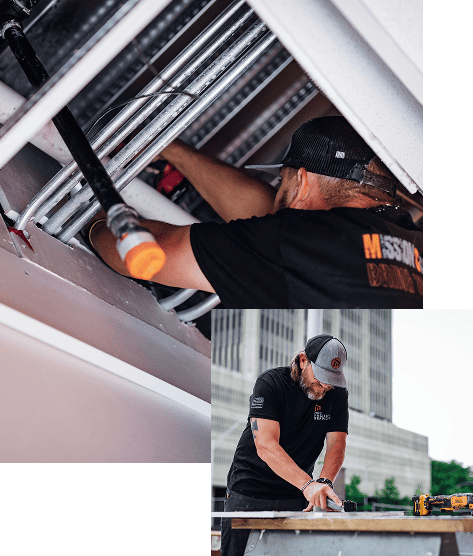Managing Maintenance Challenges in Kansas’ Unique Urban and Rural Landscapes

Kansas, often celebrated for its sweeping plains and diverse topography, presents property owners with distinct maintenance challenges. From the bustling urban centers of Kansas City to the quiet rural stretches, each area comes with unique environmental and structural considerations.
Understanding these challenges is essential for protecting investments, ensuring safety, and prolonging the lifespan of both residential and commercial properties.
Extreme Weather: A Constant Factor
One of the most significant challenges for building maintenance in Kansas is the state’s extreme weather. Situated in the heart of “Tornado Alley,” Kansas experiences an average of 87 tornadoes annually, with several historically reaching F5 or EF5 intensity . Tornadoes can cause catastrophic damage to roofs, windows, and structural elements, making emergency preparedness a critical aspect of property maintenance.
Hailstorms are another frequent concern. Hail can dent siding, crack roofs, and break glass, requiring timely inspections and repairs to prevent further deterioration.
Additionally, Kansas faces wildfire risks, particularly in its western regions. The 2021 wildfire outbreak burned over 163,000 acres and destroyed 42 structures , highlighting the need for defensible space planning and proactive property protection.
Soil Composition and Foundation Stability
Another crucial factor influencing property maintenance in Kansas is soil type. The state’s soils vary widely, with clay-rich areas prevalent in the eastern regions and sandier, drier soils in the west. Clay soils expand when wet and contract when dry, which can lead to foundation settling, cracks, and uneven floors.
Expansive soils in certain areas pose additional challenges. Moisture fluctuations can cause significant foundation movement, stressing structural components over time. Proactive solutions, such as soil stabilization techniques, proper grading, and moisture management systems, are essential to maintain long-term stability.
🏙️ Urban vs. Rural Maintenance Needs
The maintenance requirements of urban and rural properties differ considerably due to environmental exposure, building age, and access to professional services.
Urban Properties
In cities like Kansas City, urban buildings face challenges such as:
- Pollution and Humidity: Airborne pollutants and higher humidity can accelerate material degradation. Facades, metal fixtures, and paint require regular upkeep to prevent corrosion and fading.
- Urban Heat Islands: Concentrated infrastructure can increase temperatures around buildings, affecting energy efficiency and HVAC performance.
- Aging Infrastructure: Many commercial and residential buildings are decades old, lacking modern insulation or energy-efficient designs. Upgrading windows, doors, and roofing materials can enhance resilience and reduce energy costs. For instance, energy-efficient windows can reduce utility bills by 15–20% annually.
Rural Properties
Rural properties encounter a different set of challenges:
- Isolation: Distance from maintenance services can delay repairs, making preventive inspections crucial.
- Agricultural Impact: Dust, chemicals, and heavy machinery use near structures can accelerate wear.
- Exposure to Open Landscapes: Wind, lightning, and wildlife can threaten building integrity. Rural owners benefit from automated monitoring systems, backup power solutions, and durable, weather-resistant building materials.
By recognizing these differences, property owners can tailor their maintenance plans to local conditions and minimize long-term damage.
Regional Considerations Across Kansas
Kansas geography varies significantly, influencing how properties should be maintained:
- Eastern Kansas: Higher rainfall and fertile soils mean moisture management is critical. Properties may face mold growth, wood rot, and water intrusion. Solutions include proper grading, effective drainage systems, and routine inspections.
- Western Kansas: Drier conditions result in soil shrinkage and increased dust accumulation. Buildings benefit from flexible construction materials and sealing foundation gaps to reduce structural stress.
Understanding these regional variations ensures property maintenance is both effective and cost-efficient.
🛠️ Proactive Maintenance Strategies
Effective maintenance requires proactive approaches tailored to local conditions. Some best practices include:
- Routine Inspections: Identifying potential issues early prevents costly repairs and structural damage.
- Weatherproofing: Using storm-resistant windows, reinforced roofing, and insulated siding helps buildings withstand extreme conditions.
- Soil Stabilization: Techniques like retaining walls, proper drainage, and moisture barriers can mitigate soil movement and protect foundations.
- Emergency Preparedness: Developing emergency plans and maintaining backup systems minimizes damage during severe weather events.
These strategies not only safeguard property but also enhance long-term resilience.
Supporting Statistics and Insights
- Kansas has experienced 102 billion-dollar weather/climate disasters between 1980 and 2024, including storms, droughts, and floods.
- Updated building energy codes can result in life-cycle cost savings of $15,033 for commercial properties, demonstrating the financial benefits of proactive building management.
- Regular roof maintenance can extend lifespan by 10–15 years, reducing the frequency and cost of major repairs.
These figures highlight the importance of maintaining Kansas properties thoughtfully and proactively.
Leveraging Professional Support
Engaging local experts is essential for maintaining both urban and rural properties. Kansas has a network of experienced contractors, maintenance providers, and government programs that offer guidance, inspections, and sometimes grants for infrastructure improvements. Collaborating with these professionals ensures:
- Compliance with building codes and regulations.
- Tailored solutions for weather, soil, and structural challenges.
- Timely intervention to prevent small issues from becoming costly repairs.
Property owners who utilize local expertise are better equipped to safeguard their investments and maintain operational continuity.
Sustainable Maintenance Practices
Sustainability is increasingly vital in property management. By integrating environmentally friendly practices, property owners can reduce maintenance costs and environmental impact:
- Energy-Efficient Systems: Upgrading HVAC, lighting, and insulation reduces energy consumption and extends system lifespan.
- Rainwater Management: Implementing rain gardens, permeable pavements, and advanced drainage systems minimizes water-related damage.
- Durable, Local Materials: Using locally sourced, resilient construction materials reduces transportation emissions and improves compatibility with Kansas’ environmental conditions.
Sustainable practices not only protect the building but also promote long-term financial and ecological benefits.
Conclusion
Kansas’ unique urban and rural landscapes present a range of challenges for property maintenance. Extreme weather, diverse soils, regional climate variations, and aging infrastructure all require thoughtful, proactive approaches.
By tailoring strategies to specific locations, investing in preventive measures, and leveraging professional expertise, property owners can ensure the safety, longevity, and efficiency of their buildings.
For property owners in Kansas, adopting comprehensive strategies for managing building maintenance in Kansas especially in unique urban and rural landscapes, these practices are essential to protect their investments and fostering resilient communities.



